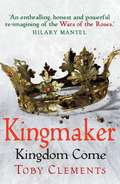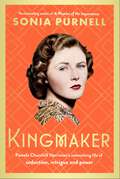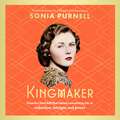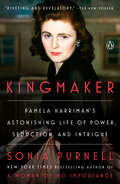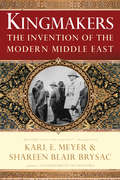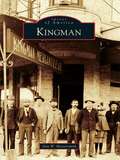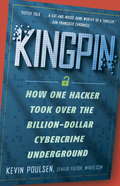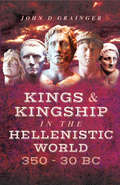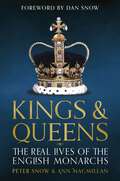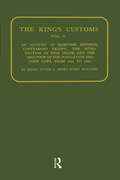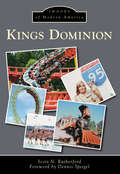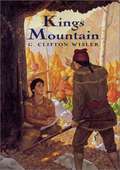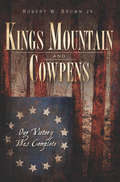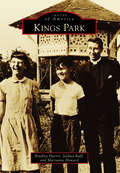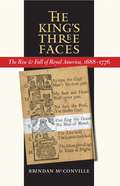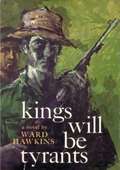- Table View
- List View
Kingmaker: (Book 2) (Kingmaker #2)
by Toby Clements'An enthralling adventure story, honest and powerful. The Wars of the Roses are imagined here with energy, with ferocity, with hunger to engage the reader.' Hilary Mantel'An enthralling adventure story, honest and powerful. The Wars of the Roses are imagined here with energy, with ferocity, with hunger to engage the reader.' Hilary MantelOctober, 1463England is a divided nation. In the north, the Lancastrian king struggles to hold power, while in the south, the princes of the house of York prepare for war.Across this land, pursued by the Church and the Law, a young man, Thomas, and a young woman, Katherine, make their way, bearing proof of a secret both sides will kill to learn.Bent on revenge for a past outrage, Thomas and Katherine journey to the mighty castle of Bamburgh to join a weakening king as he marshals his army to take up arms in one of the most savage civil wars in history: the Wars of the Roses.‘Searingly good.’ Sunday Times‘Immersive’ The Times‘Evocative and direct’ Independent
Kingmaker: (Book 3) (Kingmaker #3)
by Toby Clements'An enthralling adventure story, honest and powerful. The Wars of the Roses are imagined here with energy, with ferocity, with hunger to engage the reader.' Hilary Mantel1469: Although the Yorkist King Edward sits on his throne in Westminster, within his family there is discord as his former ally, the Earl of Warwick, continues to conspire against him. And while to one another's faces they are all smiles, their household men speak in lies and whispers. No man comes to court unarmed.As riot and rebellion stalk the land, so too do rumours of a secret, which, if proved true, will have devastating effects on the kingdom. Once again Thomas and Katherine Everingham are drawn into the fray by ruthless enemies and by past lives that refuse to be forgotten…'Mesmerising' The Times'Consistently enthralling' Daily Telegraph'Exhilarating'' Daily Express'Wonderfully accurate' Daily Mail'Rich, exciting, seamless and convincing' Hilary Mantel
Kingmaker: (Book 4) (Kingmaker #4)
by Toby Clements1470The recent tensions between King Edward and his great ally the Earl of Warwick lie forgotten these past months, but even as winter tightens her grip on the land, the peace is shattered by a vicious attack on one of the King’s allies.Long buried secrets are brought to the surface, and Thomas and Katherine must finally decide where their loyalties lie and to choose between fight or flight, knowing either choice will incur a terrible price. From Lincoln to Bruges, from Barnet to the great battle at Tewkesbury, both must play their part in one of the most savage wars in history. The wars of the roses.'Should be required reading for fans of historical fiction' The Times'Toby Clements does it again with another powerhouse of a book: thrilling and literate, engaging, passionate, deeply moving and full of historical detail of the sort that fills me with awe for the fortitude of our ancestors and yet makes me so glad I live in the safety of the twenty-first century. This is going to be one of the stellar series of our generation, redefining that period of history that we think we know, and discover we really don’t. Bravo!' Manda Scott'A major achievement in historical fiction' Historia Magazine'Clements is so convincing on the detail of his characters’ lives that it is difficult to believe that he never walked in the brutal, messy world he conjures up on the page' The Times'Toby Clements’ Kingmaker series is historical fiction at its very finest - and Kingdom Come is the best of them all.' William Ryan
Kingmaker: Pamela Churchill Harriman's astonishing life of seduction, intrigue and power
by Sonia PurnellAn electrifying re-examination of one of the twentieth century's greatest unsung power players, from the bestselling author of A WOMAN OF NO IMPORTANCE'Superb and fascinating. I can't recommend it more' LADY ANNE GLENCONNER, bestselling author of Lady in Waiting'Fascinating and revelatory, written with great aplomb, insight and shrewd analysis. A triumph' WILLIAM BOYD'An incredible story, beautifully told, of a remarkable woman whose political influence spanned Churchill to Clinton. Quite a woman, quite a read' ALASTAIR CAMPBELLWhen Pamela Churchill Harriman died in 1997, the obituaries that followed were scathing - and often downright sexist. Written off as a social climber, her glamorous social life and infamous erotic adventures overshadowed her true legacy. Much of what she did behind the scenes to shape the twentieth century, on both sides of the Atlantic, remained invisible. That is, until now: with a wealth of fresh research, Sonia Purnell unveils for the first time the full, spectacular story of how Harriman left an indelible mark on the world today.There is practically no-one in twentieth-century politics, culture and fashion whose lives she did not touch. Her influence began at age twenty, when her father-in-law, Winston Churchill, engaged her as a "secret weapon" during World War II, wining, dining and seducing Americans over to the British cause against Hitler. It continued later in the US, where she hand-picked Bill Clinton from obscurity and vaulted him to the presidency. It extended further, over five decades and two continents, influencing figures like the Kennedys, Nelson Mandela, Truman Capote, Gianni Agnelli, Kay Graham, Gloria Steinem and Frank Sinatra.Written with the novelistic richness and investigative rigour that only Sonia Purnell could bring to this story full of sex, power, yachts, palaces and fabulous clothes, Kingmaker sets out Harriman's rightful place at the heart of recent history.****'Purnell has made a statement by giving Harriman the Big Life treatment. In Purnell's hands, Kingmaker becomes a study of the limited means of influence available to ambitious women of Harriman's generation' DAILY TELEGRAPH 'Purnell's research is impeccable' SPECTATOR'Sympathetic, well-researched, busily peopled' OBSERVER BOOK OF THE DAY'Riveting and revelatory' THE NEW YORKER
Kingmaker: Pamela Churchill Harriman's astonishing life of seduction, intrigue and power
by Sonia PurnellAn electrifying re-examination of one of the twentieth century's greatest unsung power players, from the bestselling author of A WOMAN OF NO IMPORTANCE'Superb and fascinating. I can't recommend it more' LADY ANNE GLENCONNER, bestselling author of Lady in Waiting'Fascinating and revelatory, written with great aplomb, insight and shrewd analysis. A triumph' WILLIAM BOYD'Refreshing and timely; meticulously researched; highly readable ... Pamela, in Purnell's deft hands, blossoms into a fascinating subject' FINANCIAL TIMES'An incredible story, beautifully told, of a remarkable woman whose political influence spanned Churchill to Clinton. Quite a woman, quite a read' ALASTAIR CAMPBELLWhen Pamela Churchill Harriman died in 1997, the obituaries that followed were scathing - and often downright sexist. Written off as a social climber, her glamorous social life and infamous erotic adventures overshadowed her true legacy. Much of what she did behind the scenes to shape the twentieth century, on both sides of the Atlantic, remained invisible. That is, until now: with a wealth of fresh research, Sonia Purnell unveils for the first time the full, spectacular story of how Harriman left an indelible mark on the world today.There is practically no-one in twentieth-century politics, culture and fashion whose lives she did not touch. Her influence began at age twenty, when her father-in-law, Winston Churchill, engaged her as a "secret weapon" during World War II, wining, dining and seducing Americans over to the British cause against Hitler. It continued later in the US, where she hand-picked Bill Clinton from obscurity and vaulted him to the presidency. It extended further, over five decades and two continents, influencing figures like the Kennedys, Nelson Mandela, Truman Capote, Gianni Agnelli, Kay Graham, Gloria Steinem and Frank Sinatra.Written with the novelistic richness and investigative rigour that only Sonia Purnell could bring to this story full of sex, power, yachts, palaces and fabulous clothes, Kingmaker sets out Harriman's rightful place at the heart of recent history.****'In Purnell's hands, Kingmaker becomes a study of the limited means of influence available to ambitious women of Harriman's generation' DAILY TELEGRAPH'A thorough account of Harriman's rise which also manages to be a brisk, twisty read ... Riveting and revelatory' THE NEW YORKER'Purnell's research is impeccable' SPECTATOR'It might be said now that this woman with many high-profile lovers was "slut-shamed," and that her high "body count" is, while relevant to her accomplishments, no more deserving of negative judgment than that of her prominent male partners ... Purnell seeks nobly to highlight Harriman's involvement in public as well as private affairs' NEW YORK TIMES'Sympathetic, well-researched, busily peopled' OBSERVER BOOK OF THE DAY
Kingmaker: Pamela Harriman's Astonishing Life of Power, Seduction, and Intrigue
by Sonia Purnell&“A thorough account of Harriman&’s rise which also manages to be a brisk, twisty read … riveting and revelatory.&” —The New Yorker&“Rigorous but rollicking.&” —The New York TimesNamed a BEST BOOK OF THE YEAR by The New Yorker, Apple Books, The Economist, Politico, Town & Country, The Guardian, Financial Times, The Spectator, The Telegraph, The Oldie, Irish Examiner, Mail on Sunday, Daily Express, London Standard, and The Times Literary Supplement and a Must-Read Book of Fall 2024 by People MagazineFrom the New York Times bestselling and award-winning author of A WOMAN OF NO IMPORTANCE, an electrifying re-examination of one of the 20th century&’s greatest unsung power playersWhen Pamela Churchill Harriman died in 1997, the obituaries that followed were predictably scathing – and many were downright sexist. Written off as a mere courtesan and social climber, her true legacy was overshadowed by a glamorous social life and her infamous erotic adventures. Much of what she did behind the scenes – on both sides of the Atlantic - remained invisible and secret. That is, until now: with a wealth of fresh research, interviews and newly discovered sources, Sonia Purnell unveils for the first time the full, spectacular story of how she left an indelible mark on the world today.At age 20 Churchill&’s beloved daughter-in-law became a &“secret weapon&” during World War II, strategically wining, dining, and seducing diplomats and generals to help win over American sentiment (and secrets) to the British cause against Hitler. After the war, she helped to transform Fiat heir Gianni Agnelli into Italy&’s &‘uncrowned king&’ on the international stage and after moving to the US brought a struggling Democratic party back to life, hand-picking Bill Clinton from obscurity and vaulting him to the presidency.Picked as Ambassador to France, she deployed her legendary subtle powers to charm world leaders and help efforts to bring peace to Bosnia, playing her part in what was arguably the high-water mark of American global supremacy.There are few at any time who have operated as close to the center of power over five decades and two continents, and there is practically no one in 20th Century politics, culture, and fashion whose lives she did not touch, including the Kennedys, Truman Capote, Aly Khan, Kay Graham, Gloria Steinem, Ed Murrow, and Frank Sinatra. Written with the novelistic richness and investigative rigor that only Sonia Purnell could bring to this story full of sex, politics, yachts, palaces and fabulous clothes, KINGMAKER re-asserts Harriman&’s rightful place at the heart of history.
Kingmakers: The Invention of the Modern Middle East
by Karl E. Meyer Shareen Blair BrysacA brilliant narrative history tracing today's troubles back to the grandiose imperial overreach of Great Britain and the United States. Kingmakers is the gripping story of how the modern Middle East came to be, as told through the lives of the Britons and Americans who shaped it. Some are famous (Lawrence of Arabia and Gertrude Bell); others infamous (Harry St. John Philby, father of Kim); some forgotten (Sir Mark Sykes, Israel's godfather, and A. T. Wilson, the territorial creator of Iraq). All helped enthrone rulers in a region whose very name is an Anglo-American invention. The aim of this engrossing character-driven narrative is to restore to life the colorful figures who gave us the Middle East in which Americans are enmeshed today.
Kingmaking
by Helen HollickThis is the tale of Arthur flesh and bone. Of the shaping of the man, both courageous and flawed, into the celebrated ruler who inspired armies, who captured Gwenhyfar's heart, and who emerged as the hero of the Dark Ages and the most enduring hero of all time.
Kingman
by Dan W. MessersmithKingman, county seat of Mohave County in northwestern Arizona, owes its beginning and subsequent prosperity to the building of the Atlantic and Pacific Railroad in 1882. The city was named for the project's chief engineer, Lewis Kingman. The initial railroad siding quickly became a supply center for mining and ranching operations that dotted the beautiful surrounding valleys and mountain ranges. Through the years, Kingman has been at the crossroads of rail, highway, and air transportation routes. A B-17 bomber gunnery training base brought changes by exposing the area's potential to thousands of soldiers during World War II, many of whom would later return. Actor Andy Devine grew up here, Clark Gable and Carole Lombard were married here, and Charles Lindbergh would establish a route for Transcontinental Air Transport through here. Today Kingman is the "Heart of Historic U.S. Route 66" and is located in the middle of the longest remaining stretch of the "Mother Road," making it a must-see destination for thousands of tourists each year.
Kingonomics: Twelve Innovative Currencies for Transforming Your Business and Life Inspired by Dr. Martin Luther King Jr.
by Rodney SampsonWhile most know of Dr. Martin Luther King Jr.'s sweeping dream of equality and freedom for all, what many do not realize is just how keenly focused he was on economic issues, particularly in his later years. Dr. King believed without economic opportunity, we do not have the chance to pursue happiness. It was, in fact, while planning the Poor People's March, a dramatic stand on economic issues, that his voice was forever silenced. In his final book, Dr. King posed the question, where do we go from here? The answer lies in Kingonomics, a 21st-century interpretation of his economic vision translated through the eyes of Dr. Rodney Sampson, a globally established economic innovator, business developer, and highly successful serial entrepreneur. With 12 currencies (including service, innovation, and reciprocity), Sampson takes pertinent ideas from the life and works of Dr. King and, by combining them with real-life experiences, produces a guide through which one can realize their full potential and personal power. Success does not discriminate, and the road map to it is contained in the pages of this revolutionary new work.
Kingpin: How One Hacker Took Over the Billion-dollar Cyber Crime Underground
by Kevin PoulsenFormer hacker Kevin Poulsen has, over the past decade, built a reputation as one of the top investigative reporters on the cybercrime beat. In Kingpin, he pours his unmatched access and expertise into book form for the first time, delivering a gripping cat-and-mouse narrative--and an unprecedented view into the twenty-first century's signature form of organized crime. The word spread through the hacking underground like some unstoppable new virus: Someone--some brilliant, audacious crook--had just staged a hostile takeover of an online criminal network that siphoned billions of dollars from the US economy. The FBI rushed to launch an ambitious undercover operation aimed at tracking down this new kingpin; other agencies around the world deployed dozens of moles and double agents. Together, the cybercops lured numerous unsuspecting hackers into their clutches. . . . Yet at every turn, their main quarry displayed an uncanny ability to sniff out their snitches and see through their plots. The culprit they sought was the most unlikely of criminals: a brilliant programmer with a hippie ethic and a supervillain's double identity. As prominent "white-hat" hacker Max "Vision" Butler, he was a celebrity throughout the programming world, even serving as a consultant to the FBI. But as the black-hat "Iceman," he found in the world of data theft an irresistible opportunity to test his outsized abilities. He infiltrated thousands of computers around the country, sucking down millions of credit card numbers at will. He effortlessly hacked his fellow hackers, stealing their ill-gotten gains from under their noses. Together with a smooth-talking con artist, he ran a massive real-world crime ring. And for years, he did it all with seeming impunity, even as countless rivals ran afoul of police. Yet as he watched the fraudsters around him squabble, their ranks riddled with infiltrators, their methods inefficient, he began to see in their dysfunction the ultimate challenge: He would stage his coup and fix what was broken, run things as they should be run--even if it meant painting a bull's-eye on his forehead. Through the story of this criminal's remarkable rise, and of law enforcement's quest to track him down, Kingpin lays bare the workings of a silent crime wave still affecting millions of Americans. In these pages, we are ushered into vast online-fraud supermarkets stocked with credit card numbers, counterfeit checks, hacked bank accounts, dead drops, and fake passports. We learn the workings of the numerous hacks--browser exploits, phishing attacks, Trojan horses, and much more--these fraudsters use to ply their trade, and trace the complex routes by which they turn stolen data into millions of dollars. And thanks to Poulsen's remarkable access to both cops and criminals, we step inside the quiet, desperate arms race that law enforcement continues to fight with these scammers today. Ultimately, Kingpin is a journey into an underworld of startling scope and power, one in which ordinary American teenagers work hand in hand with murderous Russian mobsters and where a simple Wi-Fi connection can unleash a torrent of gold worth millions.From the Hardcover edition.
Kings & Kingship in the Hellenistic World, 350–30 BC
by John D. GraingerThe social and political aspects of ancient kingship are examined in this historical study of the Hellenistic period.For the crucial centuries between Alexander the Great and the Roman conquest of Macedon, the Mediterranean world was overwhelmingly ruled by kings. This fascinating history examines the work, experience, and preoccupations of these monarchs. Rather than presenting a chronological narrative, John Grainger takes a thematic approach, highlighting the common features as well as the differences across the various dynasties. How did one become king? How was a smooth succession secured—and what happened when it was not? What were the duties of a king, and what were the rewards and pitfalls of rule? These are just a few of the topics examined in this original and fascinating book.
Kings & Kingship in the Hellenistic World, 350–30 BC
by John D. GraingerThe social and political aspects of ancient kingship are examined in this historical study of the Hellenistic period.For the crucial centuries between Alexander the Great and the Roman conquest of Macedon, the Mediterranean world was overwhelmingly ruled by kings. This fascinating history examines the work, experience, and preoccupations of these monarchs. Rather than presenting a chronological narrative, John Grainger takes a thematic approach, highlighting the common features as well as the differences across the various dynasties. How did one become king? How was a smooth succession secured—and what happened when it was not? What were the duties of a king, and what were the rewards and pitfalls of rule? These are just a few of the topics examined in this original and fascinating book.
Kings & Queens of Great Britain: Every Question Answered
by David SoudFrom the House of Wessex to the House of Windsor, follow the pageant of personalities that have made Great Britain what it is today. Fascinating biographies of the British monarchs from the time of Roman Brittania to present day answer your every question about the country&’s aristocracy. Details of the kings&’ and queens&’ personalities are the focus, with a timeline across the bottom relating the major events of their reigns. Also included is a section devoted to royal edicts. All the Edwards, Richards, Henrys, and Williams are represented—along with outstanding personalities such as Lady Jane Grey and Oliver Cromwell—a king in all but name. This is essential reading for all Anglophiles, so brew a pot of tea and dig into the history!
Kings & Queens: The Real Lives of the English Monarchs
by Peter Snow Ann MacMillanHistorians and broadcasters Peter Snow and Ann MacMillan tell the real stories of the most powerful men and women in British history.Updated for the 2023 coronation, Kings & Queens explores the lives, loves, triumphs and disasters of a monarchy that is the envy of the world. Snow and MacMillan offer a unique insight into those born to rule, whether villains or heroes – from cruel King John and warrior-king Edward III, to our newest monarch, King Charles III.This is the story of modern civilization through the lens of those who have ruled.
Kings & Queens: The Real Lives of the English Monarchs
by Peter Snow Ann MacMillanHistorians and broadcasters Peter Snow and Ann MacMillan tell the real stories of the most powerful men and women in British history.Updated for the 2023 coronation, Kings & Queens explores the lives, loves, triumphs and disasters of a monarchy that is the envy of the world. Snow and MacMillan offer a unique insight into those born to rule, whether villains or heroes – from cruel King John and warrior-king Edward III, to our newest monarch, King Charles III.This is the story of modern civilization through the lens of those who have ruled.
Kings Customs: An Account of Maritime Revenue and Conraband Traffic
by Henry Atton Henry H. HollandFirst Published in 1968. This is Volume II of the King's Customs and gives an account of Maritime revenue, contraband traffic, the introduction of free trade and the abolition of the navigation and Corn Laws from 1801 to 1855.
Kings Dominion
by Dennis Speigel Scott N. RutherfordKings Dominion officially opened in 1975 on a 400-acre site between Richmond, Virginia, and Washington, DC. Modeled on sister park Kings Island in Ohio, it debuted with several iconic attractions, including the Eiffel Tower, Rebel Yell, and Lion Country Safari. Over the decades, ownership has changed several times, yet the park continues to grow and remain popular, even "starring" in the 1977 film Rollercoaster. Now celebrating its 40th anniversary, it has evolved into one of North America's premier regional theme parks and is currently home to an impressive assortment of attractions and live entertainment. The park also boasts a formidable arsenal of roller coasters (14), including four of the wooden variety, three LIM-launched coasters, and the 30-story-tall Intimidator (I-305) giga coaster.
Kings Mountain
by G. Clifton WislerFourteen-year-old Frank leaves his mountain home in the South to help the patriot cause during the Revolutionary War.
Kings Mountain and Cowpens: Our Victory Was Complete (Military)
by Robert W. Brown Jr.From the rocky slopes of Kings Mountain to the plains of Hannah's Cowpens, the Carolina backcountry hosted two of the Revolutionary War's most critical battles. On October 7, 1780, the Battle of Kings Mountain utilized guerilla techniques--American Over Mountain Men wearing buckskin and hunting shirts and armed with hunting rifles attacked Loyalist troops from behind trees, resulting in an overwhelming Patriot victory. In January of the next year, the Battle of Cowpens saw a different strategy but a similar outcome: with brilliant military precision, Continental Regulars, dragoons, andPatriot militia executed the war's only successful double envelopment maneuver to defeat the British. Using firsthand accounts and careful analysis of the best classic and modern scholarship on the subject, historian Robert Brown demonstrates how the combination of both battles facilitated the downfall of General Charles Cornwallis and led to the Patriot victory in America.
Kings Park (Images of America)
by Bradley Harris Joshua Ruff Marianne HowardNestled amidst a major commuter train line, a state highway, and picture-perfect views of the Long Island Sound and Nissequogue River, Kings Park balances its small-town feel with an excitingly diverse community vibrancy. Kings Park emerged in the late 19th century as the product of a utopian-inspired farm and the first state psychiatric hospital on Long Island. The community has diverse origins, with its foundation built upon thousands of incoming Irish and Italian immigrant workers and an orphanage for African American children. Throughout the 20th and early 21st centuries, Kings Park gradually evolved into a contemporary Long Island suburb, rebuilding after a traumatic downtown fire in 1917, reaping the benefits of one of the North Shore’s largest state parks (Sunken Meadow), and blossoming into a bustling family-oriented place.
Kings Three Faces: The Rise & Fall of Royal America, 1688-1776
by Brendan McconvilleReinterpreting the first century of American history, Brendan McConville argues that colonial society developed a political culture marked by strong attachment to Great Britain's monarchs.
Kings Will Be Tyrants
by Ward HawkinsKings Will Be Tyrants by Ward Hawkins is a 1959 novel about fighting in Cuba. Bernardo Manuel Patrick O'Brien is a former U.S. Marine who winds up fighting for Castro. Though a Marine, he has to deal with the conflict of his heritage, both Cuban and American.REBELS AND LOVERSThey sat side by side on the bank of the stream. In the moonlight, O’Brien could see the oval of her face, the brushed-back hair, the level hazel eyes and the soft mouth. He could see the swelling of her breasts in the open front of her shirt, the slender bare feet dangling in the water, and he could smell the many small odors that named her woman.She was very desirable. It was only in the matter of politics that they were on opposite sides. “I believe there is one matter in which we could agree,” he said softly.The girl met his searching look with a tentative smile.He reached out and put his big rough but oddly gentle hands on her shoulders and pushed her back until she was lying on the ground. She did not resist.But when he bent to put his mouth against hers, she whispered, “I have not done this before.”O’Brien tightened his arms around her. “Then it is time,” he said.Not since Hemingway’s FOR WHOM THE BELL TOLLS has there been such a gripping novel of love and war… “Dramatic, entertaining, highly readable…”—Los Angeles Times
Kings Without Castles
by Lucy Herndon Crockett“Spain is a dream world, steeped in mysticism, locked in tradition, charged with violence, inhabited by the most delightful, the most courtly, the most gracious, barbarians.”—Lucy Herndon Crockett, Kings Without CastlesFirst published in 1957, this is former Red Cross worker Lucy Herndon Crockett’s informal report on the Spain of the era, and of its people, as seen from her perspective and through her experiences.Wonderfully illustrated throughout with sketches by the author.
Kings and Connoisseurs: Collecting Art in Seventeenth-Century Europe (The A. W. Mellon Lectures in the Fine Arts #43)
by Jonathan BrownA vivid and exciting account of royal collectors, art dealers, connoisseurs, and the rise of old master paintingsOld master paintings are among the most valuable and prestigious of the visual arts, and the best examples command the highest prices of any luxury commodity. In Kings and Connoisseurs, Jonathan Brown tells the story of how painting rose to this exalted status. The transformation of painting from an inexpensive to a costly art form reached a crucial stage in the royal courts of Europe in the seventeenth century, where rulers and aristocrats assembled huge collections, often in short periods of time. By comparing collecting and collectors at these courts, Brown explains the formation of new attitudes toward pictures, as well as the mechanisms that supported the enterprise of collecting, including the emergence of the art dealer, the development of connoisseurship, and the publication of sumptuous picture books of various collections. The result is an exciting narrative of greed and passion, played out against a background of international politics and intrigue.


